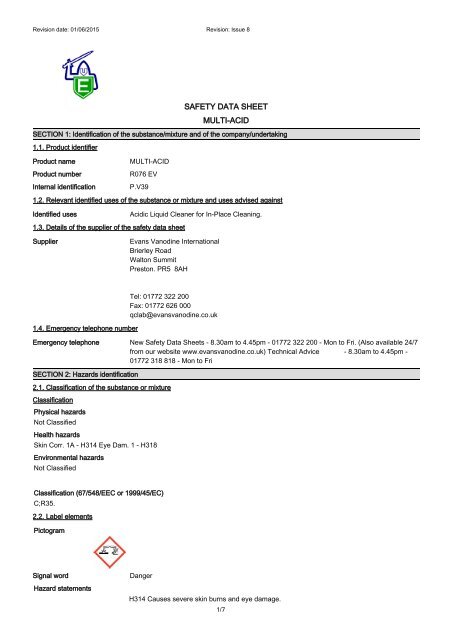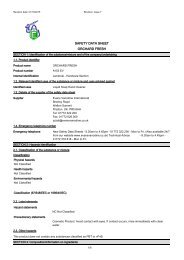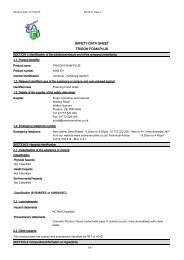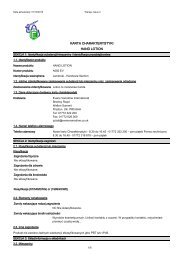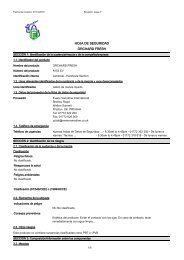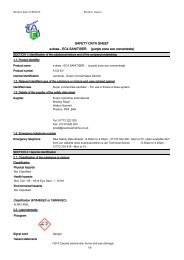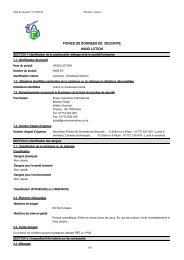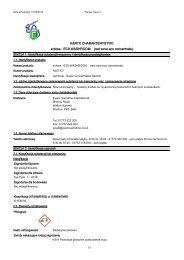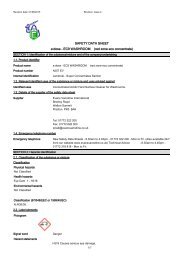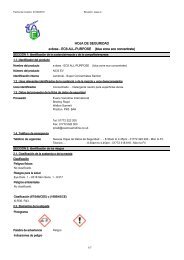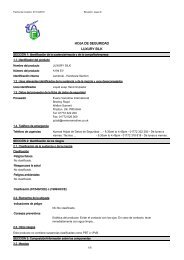SAFETY DATA SHEET MULTI-ACID
Download - Evans Vanodine
Download - Evans Vanodine
You also want an ePaper? Increase the reach of your titles
YUMPU automatically turns print PDFs into web optimized ePapers that Google loves.
Revision date: 01/06/2015 Revision: Issue 8<br />
<strong>SAFETY</strong> <strong>DATA</strong> <strong>SHEET</strong><br />
<strong>MULTI</strong>-<strong>ACID</strong><br />
SECTION 1: Identification of the substance/mixture and of the company/undertaking<br />
1.1. Product identifier<br />
Product name<br />
Product number<br />
Internal identification<br />
<strong>MULTI</strong>-<strong>ACID</strong><br />
R076 EV<br />
P.V39<br />
1.2. Relevant identified uses of the substance or mixture and uses advised against<br />
Identified uses<br />
Acidic Liquid Cleaner for In-Place Cleaning.<br />
1.3. Details of the supplier of the safety data sheet<br />
Supplier<br />
Evans Vanodine International<br />
Brierley Road<br />
Walton Summit<br />
Preston. PR5 8AH<br />
1.4. Emergency telephone number<br />
Tel: 01772 322 200<br />
Fax: 01772 626 000<br />
qclab@evansvanodine.co.uk<br />
Emergency telephone<br />
New Safety Data Sheets - 8.30am to 4.45pm - 01772 322 200 - Mon to Fri. (Also available 24/7<br />
from our website www.evansvanodine.co.uk) Technical Advice - 8.30am to 4.45pm -<br />
01772 318 818 - Mon to Fri<br />
SECTION 2: Hazards identification<br />
2.1. Classification of the substance or mixture<br />
Classification<br />
Physical hazards<br />
Not Classified<br />
Health hazards<br />
Skin Corr. 1A - H314 Eye Dam. 1 - H318<br />
Environmental hazards<br />
Not Classified<br />
Classification (67/548/EEC or 1999/45/EC)<br />
C;R35.<br />
2.2. Label elements<br />
Pictogram<br />
Signal word<br />
Hazard statements<br />
Danger<br />
H314 Causes severe skin burns and eye damage.<br />
1/7
Revision date: 01/06/2015 Revision: Issue 8<br />
<strong>MULTI</strong>-<strong>ACID</strong><br />
Precautionary statements<br />
Contains<br />
P102 Keep out of reach of children.<br />
Keep away from other chemicals especially chlorine releasing bleaches as toxic gas will be<br />
evolved.<br />
P260 Do not breathe mist.<br />
P280 Wear protective gloves/protective clothing/eye protection/face protection.<br />
P301+P330+P331 IF SWALLOWED: Rinse mouth. Do NOT induce vomiting.<br />
P303+P361+P353 IF ON SKIN (or hair): Take off immediately all contaminated clothing. Rinse<br />
skin with water/shower.<br />
P304+P340 IF INHALED: Remove person to fresh air and keep comfortable for breathing.<br />
P305+P351+P338 IF IN EYES: Rinse cautiously with water for several minutes. Remove<br />
contact lenses, if present and easy to do. Continue rinsing.<br />
P315 Get immediate medical advice/attention.<br />
P501 Dispose of contents/container in accordance with local regulations.<br />
NITRIC <strong>ACID</strong> ...%, PHOSPHORIC <strong>ACID</strong> ...%<br />
2.3. Other hazards<br />
This product does not contain any substances classified as PBT or vPvB.<br />
SECTION 3: Composition/information on ingredients<br />
3.2. Mixtures<br />
NITRIC <strong>ACID</strong> ...% 25-30%<br />
CAS number: 7697-37-2 EC number: 231-714-2<br />
Classification<br />
Ox. Liq. 3 - H272<br />
Skin Corr. 1A - H314<br />
Eye Dam. 1 - H318<br />
Classification (67/548/EEC or 1999/45/EC)<br />
O;R8 C;R35<br />
PHOSPHORIC <strong>ACID</strong> ...% 10-15%<br />
CAS number: 7664-38-2 EC number: 231-633-2<br />
Classification<br />
Skin Corr. 1B - H314<br />
Classification (67/548/EEC or 1999/45/EC)<br />
C;R34<br />
The Full Text for all R-Phrases and Hazard Statements are Displayed in Section 16.<br />
SECTION 4: First aid measures<br />
4.1. Description of first aid measures<br />
Inhalation<br />
Unlikely route of exposure as the product does not contain volatile substances. If spray/mist has been inhaled, proceed as<br />
follows. Move affected person to fresh air and keep warm and at rest in a position comfortable for breathing.<br />
Ingestion<br />
Do not induce vomiting. Rinse mouth thoroughly with water. Give plenty of water to drink. Get medical attention immediately.<br />
Skin contact<br />
Wash with plenty of water. Get medical attention promptly if symptoms occur after washing.<br />
Eye contact<br />
Rinse immediately with plenty of water. Remove any contact lenses and open eyelids wide apart. Continue to rinse. Get<br />
medical attention immediately.<br />
4.2. Most important symptoms and effects, both acute and delayed<br />
General information<br />
The severity of the symptoms described will vary dependent on the concentration and the length of exposure.<br />
2/7
Revision date: 01/06/2015 Revision: Issue 8<br />
Inhalation<br />
Irritation of nose, throat and airway.<br />
Ingestion<br />
May cause chemical burns in mouth and throat.<br />
Skin contact<br />
<strong>MULTI</strong>-<strong>ACID</strong><br />
Burning pain and severe corrosive skin damage. May cause serious chemical burns to the skin.<br />
Eye contact<br />
Severe irritation, burning and tearing. Prolonged contact causes serious eye and tissue damage.<br />
4.3. Indication of any immediate medical attention and special treatment needed<br />
Notes for the doctor<br />
Treat symptomatically.<br />
SECTION 5: Firefighting measures<br />
5.1. Extinguishing media<br />
Suitable extinguishing media<br />
The product is not flammable. Use fire-extinguishing media suitable for the surrounding fire.<br />
5.2. Special hazards arising from the substance or mixture<br />
Specific hazards<br />
Thermal decomposition or combustion products may include the following substances: Irritating gases or vapours.<br />
5.3. Advice for firefighters<br />
Special protective equipment for firefighters<br />
Wear positive-pressure self-contained breathing apparatus (SCBA) and appropriate protective clothing.<br />
SECTION 6: Accidental release measures<br />
6.1. Personal precautions, protective equipment and emergency procedures<br />
Personal precautions<br />
Wear protective clothing, gloves, eye and face protection. For personal protection, see Section 8.<br />
6.2. Environmental precautions<br />
Environmental precautions<br />
Spillages or uncontrolled discharges into watercourses must be reported immediately to the Environmental Agency or other<br />
appropriate regulatory body.<br />
6.3. Methods and material for containment and cleaning up<br />
Methods for cleaning up<br />
Small Spillages: Flush away spillage with plenty of water. Large Spillages: Contain and absorb spillage with sand, earth or other<br />
non-combustible material. Collect and place in suitable waste disposal containers and seal securely.<br />
6.4. Reference to other sections<br />
Reference to other sections<br />
For personal protection, see Section 8.<br />
SECTION 7: Handling and storage<br />
7.1. Precautions for safe handling<br />
Usage precautions<br />
Wear protective clothing, gloves, eye and face protection.<br />
7.2. Conditions for safe storage, including any incompatibilities<br />
Storage precautions<br />
Keep only in the original container in a cool, well-ventilated place. Store away from the following materials: Oxidising materials.<br />
(eg Hypochlorite / Bleach)<br />
3/7
Revision date: 01/06/2015 Revision: Issue 8<br />
7.3. Specific end use(s)<br />
<strong>MULTI</strong>-<strong>ACID</strong><br />
Specific end use(s)<br />
The identified uses for this product are detailed in Section 1.2.<br />
Usage description<br />
See Product Information Sheet & Label for detailed use of this product.<br />
SECTION 8: Exposure Controls/personal protection<br />
8.1. Control parameters<br />
Occupational exposure limits<br />
NITRIC <strong>ACID</strong> ...%<br />
Short-term exposure limit (15-minute): WEL 1 ppm 2.6 mg/m3<br />
PHOSPHORIC <strong>ACID</strong> ...%<br />
Long-term exposure limit (8-hour TWA): WEL 1 mg/m3<br />
Short-term exposure limit (15-minute): WEL 2 mg/m3<br />
WEL = Workplace Exposure Limit<br />
8.2. Exposure controls<br />
Protective equipment<br />
Appropriate engineering controls<br />
Not relevant.<br />
Eye/face protection<br />
The following protection should be worn: Chemical splash goggles or face shield.<br />
Hand protection<br />
Wear protective gloves. Polyvinyl chloride (PVC).<br />
Other skin and body protection<br />
Wear appropriate clothing to prevent any possibility of skin contact.<br />
Respiratory protection<br />
Respiratory protection not required.<br />
SECTION 9: Physical and Chemical Properties<br />
9.1. Information on basic physical and chemical properties<br />
Appearance<br />
Liquid.<br />
Colour<br />
Clear. Colourless.<br />
Odour<br />
Sharp odour, characteristic of nitric acid.<br />
pH<br />
pH (concentrated solution):
Revision date: 01/06/2015 Revision: Issue 8<br />
Relative density<br />
1.260 @ 20°C<br />
Solubility(ies)<br />
Soluble in water.<br />
<strong>MULTI</strong>-<strong>ACID</strong><br />
9.2. Other information<br />
Other information<br />
None.<br />
SECTION 10: Stability and reactivity<br />
10.1. Reactivity<br />
Reacts with alkalis and generates heat.<br />
10.2. Chemical stability<br />
Stability<br />
No particular stability concerns.<br />
10.3. Possibility of hazardous reactions<br />
See sections 10.1,10.4 & 10.5<br />
10.4. Conditions to avoid<br />
There are no known conditions that are likely to result in a hazardous situation.<br />
10.5. Incompatible materials<br />
Materials to avoid<br />
Strong alkalis. Chlorine releasing materials will liberate toxic chlorine gas.<br />
10.6. Hazardous decomposition products<br />
No known hazardous decomposition products.<br />
SECTION 11: Toxicological information<br />
11.1. Information on toxicological effects<br />
Toxicological effects<br />
We have not carried out any animal testing for this product. Any ATE figures quoted below are from Toxicity Classifications that<br />
have been carried out using ATE (Acute Toxicity Estimate) Calculation Method using LD50 or ATE figures provided by the Raw<br />
Material Manufacturer.<br />
SECTION 12: Ecological Information<br />
Ecotoxicity<br />
The product may affect the acidity (pH) of water which may have hazardous effects on aquatic organisms.<br />
12.1. Toxicity<br />
We have not carried out any Aquatic testing, therefore we have no Aquatic Toxicity Data specifically for this product. The<br />
Aquatic Toxicity Data, where provided by the raw material manufacturer for ingredients with aquatic toxicity, can be made<br />
available on request.<br />
12.2. Persistence and degradability<br />
Persistence and degradability<br />
This product, at use dilutions, is readily broken down in biological effluent treatment plants.<br />
12.3. Bioaccumulative potential<br />
The product does not contain any substances expected to be bioaccumulating.<br />
12.4. Mobility in soil<br />
Mobility<br />
Not known.<br />
12.5. Results of PBT and vPvB assessment<br />
5/7
Revision date: 01/06/2015 Revision: Issue 8<br />
<strong>MULTI</strong>-<strong>ACID</strong><br />
This product does not contain any substances classified as PBT or vPvB.<br />
12.6. Other adverse effects<br />
Not known.<br />
SECTION 13: Disposal considerations<br />
13.1. Waste treatment methods<br />
Disposal methods<br />
Discharge used solutions to drain. Small amounts (less than 5 Litres) of unwanted product may be flushed with water to sewer.<br />
Larger volumes must be sent for disposal as special waste. Rinse out empty container with water and consign to normal waste.<br />
SECTION 14: Transport information<br />
14.1. UN number<br />
UN No. (ADR/RID)<br />
UN No. (IMDG)<br />
UN No. (ICAO)<br />
3264<br />
3264<br />
3264<br />
14.2. UN proper shipping name<br />
Proper shipping name<br />
(ADR/RID)<br />
Proper shipping name (IMDG)<br />
Proper shipping name (ICAO)<br />
Proper shipping name (ADN)<br />
CORROSIVE LIQUID, <strong>ACID</strong>IC, INORGANIC, N.O.S. (nitric acid and phosphoric acid solution)<br />
CORROSIVE LIQUID, <strong>ACID</strong>IC, INORGANIC, N.O.S. (nitric acid and phosphoric acid solution)<br />
CORROSIVE LIQUID, <strong>ACID</strong>IC, INORGANIC, N.O.S. (nitric acid and phosphoric acid solution)<br />
CORROSIVE LIQUID, <strong>ACID</strong>IC, INORGANIC, N.O.S. (nitric acid and phosphoric acid solution)<br />
14.3. Transport hazard class(es)<br />
ADR/RID class<br />
ADR/RID label<br />
IMDG class<br />
ICAO class/division<br />
Class 8: Corrosive substances.<br />
8<br />
Class 8: Corrosive substances.<br />
Class 8: Corrosive substances.<br />
ICAO subsidiary risk<br />
Transport labels<br />
14.4. Packing group<br />
ADR/RID packing group<br />
IMDG packing group<br />
ICAO packing group<br />
II<br />
II<br />
II<br />
14.5. Environmental hazards<br />
Environmentally hazardous substance/marine pollutant<br />
No.<br />
14.6. Special precautions for user<br />
EmS<br />
F-A, S-B<br />
Emergency Action Code<br />
Hazard Identification Number<br />
(ADR/RID)<br />
Tunnel restriction code<br />
(E)<br />
6/7
Revision date: 01/06/2015 Revision: Issue 8<br />
<strong>MULTI</strong>-<strong>ACID</strong><br />
14.7. Transport in bulk according to Annex II of MARPOL73/78 and the IBC Code<br />
Not relevant. for a packaged product.<br />
SECTION 15: Regulatory information<br />
15.1. Safety, health and environmental regulations/legislation specific for the substance or mixture<br />
EU legislation<br />
Safety Data Sheet prepared in accordance with REACH Commission Regulation (EU) No 453/2010 (which amends Regulation<br />
(EC) No 1907/2006). The product is as classified under GHS/CLP- Regulation (EC) No 1272/2008 classification, labelling &<br />
packaging of substances & mixtures. Ingredients are listed with classification under both CHIP - Directive 67/548/EEC -<br />
classification, packaging & labelling of dangerous substances & GHS/CLP- Regulation (EC) No 1272/2008 classification,<br />
labelling & packaging of substances & mixtures.<br />
Guidance<br />
Workplace Exposure Limits EH40.<br />
15.2. Chemical safety assessment<br />
No chemical safety assessment has been carried out as not applicable as this product is a mixture.<br />
SECTION 16: Other information<br />
Key literature references and sources for data<br />
Material Safety Data Sheet, Misc. manufacturers. CLP Class - Table 3.1 List of harmonised classification and labeling of<br />
hazardous substances. CHIP Class - Table 3.2 The list of harmonised classification and labelling of hazardous substances from<br />
Annex I to Directive 67/548/EEC. ECHA - C&L Inventory database.<br />
Revision comments<br />
This product is now using classification from GHS/CLP - Regulation (EC) No 1272/2008 classification, labelling & packaging of<br />
substances & mixtures.<br />
Revision date<br />
01/06/2015<br />
Revision<br />
SDS status<br />
Risk phrases in full<br />
Hazard statements in full<br />
Issue 8<br />
The Risk Phrases / Hazard Statements listed below in this Section No 16 relate to the Raw<br />
Materials (Ingredients) in the Product (as listed in Section 3) and NOT the product itself. For the<br />
Risk Phrases / Hazard Statements relating to this Product see Section 2.<br />
R34 Causes burns.<br />
R35 Causes severe burns.<br />
R8 Contact with combustible material may cause fire.<br />
H272 May intensify fire; oxidiser.<br />
H314 Causes severe skin burns and eye damage.<br />
H318 Causes serious eye damage.<br />
7/7


